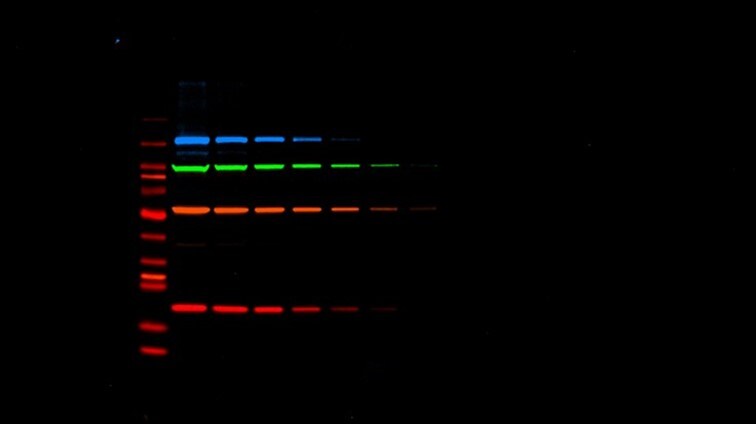Table of Contents
Pros of western blotting
Cons of western blotting
When to use ELISA for protein analysis
When to use western blotting for protein analysis
More tools and resources
by Frances Gatta
Enzyme-linked immunosorbent Assay (ELISA) and western blot are invaluable methods for identifying, quantifying, and analyzing proteins.
ELISA is a highly sensitive, specific, and versatile technique that can detect proteins in complex biological samples, even at nanomolar concentrations. It is relatively simple to perform and can be used to analyze many samples at once. However, it is more likely than a western blot to generate false positive or negative results and cannot provide comprehensive information about the target protein.
On the other hand, though western blotting can be a more complex workflow, it generally provides clear and easy-to-interpret results. It is often used as a confirmatory tool for results generated from ELISA and other assays.
What is ELISA (Enzyme-Linked Immunosorbent Assay)?
Enzyme-linked immunosorbent assay or ELISA is a highly sensitive and specific enzyme immunoassay technique for quantitatively and qualitatively analyzing antibodies or antigens, including proteins, hormones, peptides, nucleic acids, and more.
ELISA is performed in 96-well polystyrene absorbent plates. These plates enable antibody or antigen adhesion and allow many samples to be screened in the same experiment.
ELISA may be performed following four general steps: coating the plates with an antibody or antigen, blocking with bovine serum albumin (BSA) or other molecules, detecting by adding a substrate that produces color, and reading the results.
ELISA has four main types, including
- Direct ELISA: Here, an antigen-coated plate is used to test an antibody.
- Indirect ELISA: With this type, an antigen-coated plate is used to screen an antigen or antibody.
- Sandwich ELISA: It screens antigens with an antibody-coated plate. The antigen is sandwiched between the capture and detection antibodies, hence the name.
- Competitive ELISA: This test is used to detect antibodies that are specific to antigens found in the serum being tested.

Diagram of common ELISA formats (direct vs. sandwich assays). In the assay, the antigen of interest is immobilized by direct adsorption to the assay plate or by first attaching a capture antibody to the plate surface. Detection of the antigen can then be performed using an enzyme-conjugated primary antibody (direct detection) or a matched set of unlabeled primary and conjugated secondary antibodies (indirect detection).
Pros and Cons of ELISA
Pros
- It is a time-efficient method for determining whether protein is present or absent in a sample.
- It follows a simple and quick process, requiring little sample preparation.
- It is a more sensitive immunoassay and can detect a single protein or low protein concentrations in a sample.
- It can perform multiple analyses at a time.
- It uses lower-cost reagents, making it cost-effective for demanding budgets, especially for experienced users who could opt for uncoated ELISA kits.
Cons
- It is limited in specificity and is more likely to provide false positive or negative results due to technical errors, sample contamination, use of low-quality reagents, and more.
- ELISA kit antibodies must be transported and stored in a refrigerator as they are susceptible to instability.
- It cannot be relied on to generate other information about the target protein, such as its mass and abundance.
What is a western blot?
A western blot, also called immunoblot, is a routine technique for detecting and quantifying target proteins, including low levels of proteins in a complex mixture. It is a valuable assay for identifying and undersatnding protein characterization elements, protein-protein interactions, modifications, and more.
Western blot is performed first by separating the proteins from the mixture using gel electrophoresis based on their molecular weights. The separated proteins are transferred from the gel and bound to a protein-binding membrane. Finally, the membrane is probed with an antibody to the protein of interest, allowing for its detection on the membrane surface.

Fluorescent western blot image example captured with an iBright Imaging System.
Pros and Cons of Western Blot
Pros
- When performed well, it can provide precise, easy-to-interpret results.
- It offers high specificity, identifying a target protein from thousands as in complex samples like lysates.
- It can provide information on the molecular weight of the target protein in one experiment, along with identifying small modifications and providing visual identification across proteins that may share otherwise similar properties.
Cons
- It is often best used as a confirmatory rather than fully quantitative tool.
- It can be a costly and time-consuming procedure.
- The detection signal can diminish rapidly, unless long-duration substrates (8-24 hours) or fluorescent dyes are used.
- It is more sensitive to sample preparation impurities that can lead to high background noise or other detection difficulties.
ELISA vs. Western Blot
ELISA and western blot are two popular methods for detecting and analyzing proteins. While ELISA is an exceptional tool for protein detection and quantification, the western blot is often used to confirm the result of an ELISA test as it is more likely to provide a definite result. It can also obtain extensive information—including the size and abundance—on the target protein from a complex mixture rather than a yes or no answer, as in ELISA.
Here’s a guide on when to use each technique for protein detection and quantitation.
When to use ELISA for protein analysis
As the most sensitive immunoassay, you can rely on ELISA’s high sensitivity for detecting small amounts of target proteins, rare proteins, and low-abundance proteins. When you need to quantify protein concentration precisely, ELISA is better. Western blot can only measure relative protein abundance and not absolute concentration.
Speed is another reason to choose ELISA over Western blot. ELISA protocols are faster and require minimal sample preparation, making it suitable for routinely performed assays. Unlike western blotting, ELISA’s microplates and readers enable the quick analysis of samples.
The ELISA process is a more straightforward method, too. It uses lower sample volumes and standard 96-well plates and allows for multiplexing. It can also be automated, reducing errors and repetitive hands-on tasks. Opt for this process if you need a high-throughput or automated lab setup. Following these, teaching ELISA to junior-level scientists can be easier than western blotting, which is more complex, involving gel separation, membrane transfer, imaging, and more.
More, ELISA is sufficient if you only need to know if the protein is present or absent and potentially check its concentration.
Learn how to choose the right ELISA kit format >>
When to use a western blot for protein analysis
The western blot is best for detecting a wide range of proteins from a complex mixture or sample. Another key reason to use Western blot is that it is highly specific in measuring proteins, even at relatively low levels.
Suppose you need more information about the protein, like its molecular weight, purity, details regarding protein-protein interaction, protein expression changes, or post-translational modifications. In that case, the western blot can be a powerful tool.
Western blot is also an excellent option if you are confident in the specificity of your binding antibody and that it can detect non-target proteins. Fluorescent western detection in particular enables multiplexing to examine many proteins in a single experiment.
Lastly, the western blot is often used as a confirmatory tool for many complimentary protein analysis methods like ELISA or mass spectroscopy, particularly in clinical settings for medical diagnosis, as it’s reliable for ruling out false positives or negatives.
Check out our 2024 Guide to Quantitative Western Blot Publication >>
More Tools & Resources
ELISA
- One-Stop Guide to ELISA Products and Accessories including ready-to-use kits, microplates and readers, plasticware, blocking buffers and reagents, instrumentation, and other equipment
- Microplate Readers for ELISA plates and beyond
- ELISA Kits and Components with information about choosing the right kit format
- ELISA Overview including detailed explanations of ELISA assay approaches
- ELISA Builder tool to help you develop your own unique assay setup
Western Blot
- Western Blotting Hub including workflow product directory, protocols, recipes, handbooks, webinars, and more
- iWestern Workflow for streamlining your western blotting process
- iBlot 3 Western Blot Transfer System for protein transfer
- iBright Imaging Systems for western analysis
- Western Blot Education Center including how-to videos, troubleshooting guides, and library resources
» Still curious? Explore the Protein Analysis Learning Center: thermofisher.com/proteinlearning
Want to read more stories like this? Subscribe to Connect to Science, your portal for life science news.
##
References
Sakamoto S, Putalun W, Vimolmangkang S, et al. Enzyme-linked immunosorbent assay for the quantitative/qualitative analysis of plant secondary metabolites [published correction appears in J Nat Med. 2018 Jan 5;:]. J Nat Med. 2018;72(1):32-42. doi:10.1007/s11418-017-1144-z
(n.d.). British Society of Immunology. Enzyme-linked immunosorbent assay (ELISA). Retrieved from https://www.immunology.org/public-information/bitesized-immunology/experimental-techniques/enzyme-linked-immunosorbent-assay
Alhajj M, Zubair M, Farhana A. Enzyme-Linked Immunosorbent Assay. [Updated 2023 Apr 23]. In: StatPearls [Internet]. Treasure Island (FL): StatPearls Publishing; 2023 Jan-. Available from: https://www.ncbi.nlm.nih.gov/books/NBK555922/
Sakamoto S, Putalun W, Vimolmangkang S, et al. Enzyme-linked immunosorbent assay for the quantitative/qualitative analysis of plant secondary metabolites [published correction appears in J Nat Med. 2018 Jan 5;:]. J Nat Med. 2018;72(1):32-42. doi:10.1007/s11418-017-1144-z
Ghosh R, Gilda JE, Gomes AV. The necessity of and strategies for improving confidence in the accuracy of western blots. Expert Rev Proteomics. 2014;11(5):549-560. doi:10.1586/14789450.2014.939635
Tie L, Xiao H, Wu DL, Yang Y, Wang P. A brief guide to good practices in pharmacological experiments: Western blotting. Acta Pharmacol Sin. 2021;42(7):1015-1017. doi:10.1038/s41401-020-00539-7
(2023). National Human Genome Research Institute. Western Blot. Retrieved from https://www.genome.gov/genetics-glossary/Western-Blot
Gilda JE, Ghosh R, Cheah JX, West TM, Bodine SC, Gomes AV. Western Blotting Inaccuracies with Unverified Antibodies: Need for a Western Blotting Minimal Reporting Standard (WBMRS). PLoS One. 2015;10(8):e0135392. Published 2015 Aug 19. doi:10.1371/journal.pone.0135392
Begum H, Murugesan P, Tangutur AD. Western blotting: a powerful staple in scientific and biomedical research. Biotechniques. 2022;73(1):58-69. doi:10.2144/btn-2022-0003
© 2024 Thermo Fisher Scientific Inc. All rights reserved. All trademarks are the property of Thermo Fisher Scientific and its subsidiaries unless otherwise specified.
For Research Use Only. Not for use in diagnostic procedures.

Leave a Reply